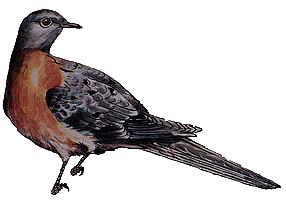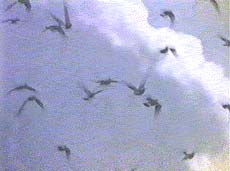

PASSENGER PIGEON

The Passenger Pigeon was once one of the most numerous birds on earth, so numerous that flocks of birds would darken the sky as they passed overhead in search for feeding and breeding grounds. Its range covered eastern North America and historical accounts suggest that the species made up 25 to 40% of the total land bird population of the United States.
The sheer numbers of birds in flight gave the appearance of a school of iridescent fish as they moved in solid gleaming masses, dipping and turning and tumbling through the sky. They would fly high above the ground until suitably rich land was spotted at which point they would wheel about and descend in a huge circle. Once on the ground they would efficiently demolish the available berries and seeds by a spectacular system that involved the back ranks rising up and passing over the main flock and land in front. In a scientific report on the birds of Ohio of 1882, the scientist J. M. Wheaton described a flock feeding: "This movement soon became continuous and uniform, birds from the rear flying to the front so rapidly that the whole presented the appearance of a rolling cylinder having a diameter of about 50 yards, its interior filled with flying leaves and grass"

